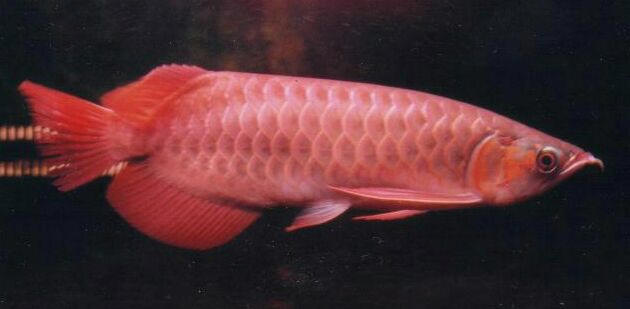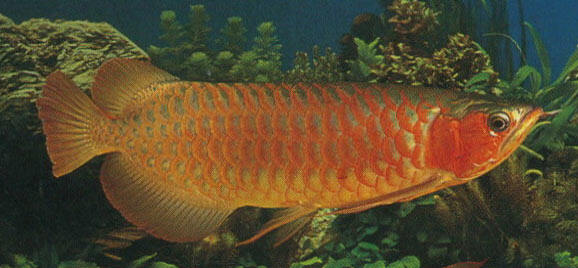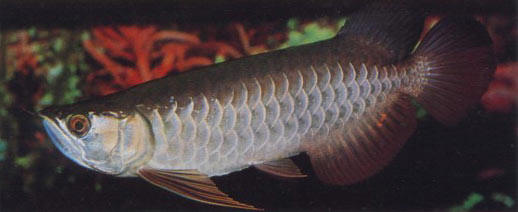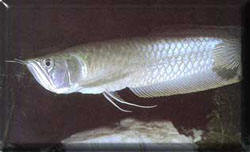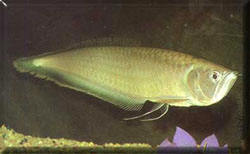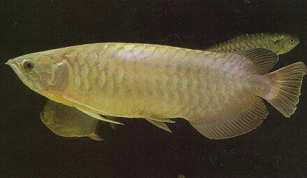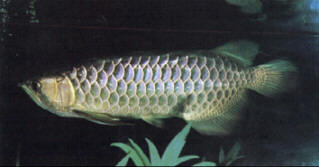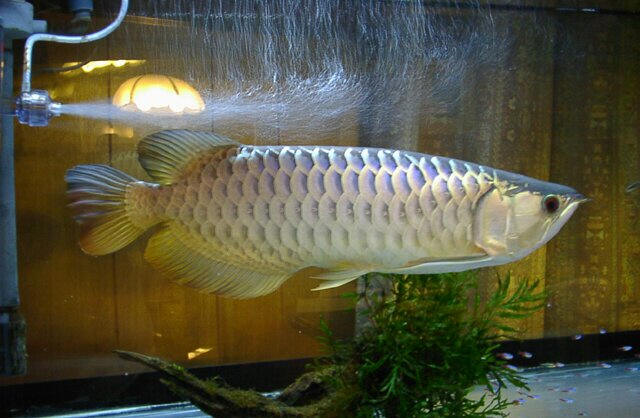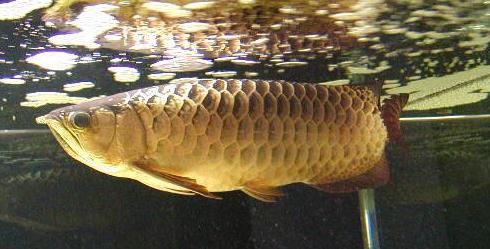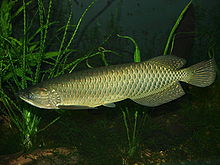The Asian arowana comprises several varieties of freshwater fish in the genus
Scleropages. Some sources differentiate these varieties into multiple species,
[1][2] while others consider the different strains to belong to a single species,
Scleropages formosus.
[3] They have several other common names, including
Asian bonytongue,
dragon fish, and a number of names specific to different varieties.
Native to Southeast Asia, Asian arowanas inhabit blackwater rivers, slow-moving waters flowing through forested swamps and wetlands. Adults feed on other fish, while juveniles feed on insects.
[4]
These popular aquarium fish have special cultural significance in areas influenced by Chinese culture. The name
dragon fish stems from their resemblance to the Chinese dragon. This popularity has had both positive and negative effects on their status as endangered species.
Contents- 1 Evolution and taxonomy
- 2 Description
- 3 Behavior
- 4 Relationship with humans
- 4.1 Cultural beliefs
- 4.2 Conservation
- 4.3 Care in captivity
- 5 See also
- 6 Notes
- 7 References
- 8 External links
|
Like all members of Osteoglossidae, Asian arowanas are highly adapted to fresh water and are incapable of surviving in the ocean. Therefore, their spread throughout the islands of southeast Asia suggests they diverged from other osteoglossids before the continental breakup was complete. Genetic studies have confirmed this hypothesis, showing that their ancestor of the Asian arowanas diverged from the ancestor of the Australian arowanas,
S. jardinii and
S. leichardti, about 140 million years ago, during the Early Cretaceous period. This divergence took place in the eastern margin of Gondwanaland, with the ancestors of Asian arowanas carried on the Indian subcontinent or smaller landmasses into Asia. The morphological similarity of all
Scleropages species shows that little evolutionary change has taken place recently for these ancient fish.
[5]
The first description of these species was published between 1839 and 1844 (1844 is the date commonly cited) by German naturalists Salomon Müller and Hermann Schlegel, under the name
Osteoglossum formosum, although later this species was placed in
Scleropages with the name
S. formosus.
[6]
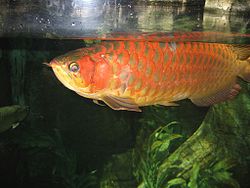
Super red arowana in a public aquarium.
Several distinct, naturally occurring colour varieties are recognised, each found in a specific geographic region. They include the following:
- The green is the most common variety, found in Indonesia (Kalimantan and Sumatra), Vietnam, Myanmar, Thailand, Cambodia, and Malaysia.
- The silver Asian (not to be confused with the silver arowana, Osteoglossum bicirrhosum) is considered part of the green variety by some. It has two subvarieties, the "grey tail silver" or "Pinoh arowana," and the "yellow tail silver," each found in a different part of the island of Borneo in Indonesia.
- The red-tailed golden is found in northern Sumatra, Indonesia.
- The gold crossback, blue Malayan, or Bukit Merah blue is native to the state of Pahang and the Bukit Merah area in Perak, Peninsular Malaysia.
- The red, super red, blood red, or chili red is known only from the upper part of the Kapuas River and nearby lakes in western Borneo, Indonesia.
In 2003, a study
[1] was published which proposed breaking
S. formosus into four separate species. This classification was based on both morphology and genetics, and includes the following species:
- Scleropages formosus was redescribed to include the strain known as the green arowana. The gold crossback, which was not part of the study, was included in this species by default, though it was suspected that it was closely related to S. aureus.
- Scleropages macrocephalus described the silver Asian arowana.
- Scleropages aureus described the red-tailed golden arowana.
- Scleropages legendrei described the super red arowana.
Other researchers dispute this reclassification, arguing that the published data are insufficient to justify recognizing more than one Southeast Asian species of
Scleropages.
[3]

Asian arowana scales are large (most over 2 cm in length) and have a delicate net pattern.
Asian arowanas grow up to 90 cm (35 in) total length.
[7] Like all
Scleropages, Asian arowanas have long bodies; large, elongate pectoral fins; dorsal and anal fins located far back on the body; and a much larger caudal fin than that of their South American relative, the silver arowana,
Osteoglossum bicirrhosum. The mouth is oblique with a very wide gape. The prominent lower jaw has two barbels at its tip. The gill rakers are stout. Asian arowanas bear teeth on many bones of the mouth, including the jaws, vomer, palatines, pterygoids, parasphenoid, and tongue.
[8]
Asian arowana scales are large, cycloid, and, in some varieties, metallic coloured, with a distinctive mosaic pattern of raised ribs.
[1][9] The lateral scales are arranged in horizontal rows numbered from the most ventral (first level) to the most dorsal (fifth level), with dorsal scales designated the sixth level.
[10]
Asian arowanas are distinguished from Australian congenerics
S. jardinii and
S. leichardti by having fewer (21-26) lateral line scales (versus 32-36 for the Australian species), longer pectoral and pelvic fins, and a longer anterior snout.
[1]
Green arowanas are dark green on the back, silvery or golden green on its sides, and silvery or whitish on its ventral surface, with dark greenish or bluish patches visible through the lateral scales. In mature fish, the top of the eye and the head behind the eye are bright emerald.
[1]
Both grey-tailed and yellow-tailed silver Asian arowanas are dark grey on the back and silver on the sides, with dark ring patches on the lateral scales and a silvery or whitish belly. In yellow-tailed specimens, the fin membranes are yellowish with dark grey rays. In grey-tailed specimens, the fins are uniform dark grey.
[1]

Red-tailed golden arowana. Although the scales are golden, the anal and caudal fins are reddish-brown.
Mature red-tailed golden arowanas have brilliant metallic gold lateral scales, gill covers, bellies, and pectoral and pelvic fin membranes, although the back is dark. In juveniles the areas destined to develop golden colour start out metallic silver. The anal fin and the bottom portion of the caudal fin are light brown to dark red.
[1]
Mature gold crossback arowanas are distinguished from the red-tailed golden arowanas by having metallic gold crossing the back completely. This variety also lacks the reddish fins of the red-tailed golden.
[11]
In mature super red arowanas, the gill covers, lateral scales, and fin membranes of these fishes are metallic red, with the exact hue varying from gold-tinged to deep red. The back is dark brown. In juveniles, the darker the dorsal colouration, the deeper the red will be on maturity.
[1]
Asian arowanas are paternal mouthbrooders. They are slow to reach sexual maturity and difficult to breed in captivity; successful spawnings typically take place in large outdoor ponds rather than in aquaria.
[12]
Two breeders reported success using a garden pond measuring 18 feet (5.5 m) by 18 feet (5.5 m) by 3.5 feet (1.1 m) deep, with pH maintained between 6.5 and 7.0. The fish were over five years old. The successful harvest took place after the third spawning; in the first two spawnings, the male swallowed the eggs, possibly due to improper water quality.
[13]
Asian arowanas are considered "lucky" by many people, particularly those from Asian cultures. This reputation derives from the species' resemblance to the Chinese dragon, considered an auspicious symbol.
[14] The large metallic scales and double barbels are features shared by the Chinese dragon, and the large pectoral fins are said to make the fish resemble "a dragon in full flight."
[10]
In addition, positive Feng Shui associations with water and the colours red and gold make these fishes popular for aquariums. One belief is that while water is a place where chi gathers, it is naturally a source of yin energy and must contain an "auspicious" fish such as an arowana in order to have balancing yang energy.
[11] Another is that a fish can preserve its owner from death by dying itself.
[15]
The Asian arowanas are listed as endangered by the 2006 IUCN Red List, with the most recent evaluation taking place in 1996.
[16] International trade in these fishes is controlled under the Convention on the International Trade in Endangered Species of Wild Flora and Fauna (CITES), under which it was placed on Appendix I, the most restrictive category, in 1975.
[17] S. formosus is one of only eight fish species listed on Appendix I.
[18] There are a number of registered CITES breeders in Asia and the specimens they produce can be imported into several nations. Other nations restrict or prohibit possession of Asian arowanas; for example, the United States has listed this species under the Endangered Species Act, and therefore it cannot be possessed in that country without a permit.
[19]
Declining habitat is a major threat. For example, Asian arowanas are now uncommon in the Malay Peninsula, where they were once widely distributed, due to environmental destruction.
[20] Inclusion in the IUCN Red List was originally based not on biological reasons but on practical ones: though widely distributed throughout southeast Asia, they have been harvested heavily by aquarium collectors. However, habitat loss is likely a greater threat than aquarium collecting.
[21]
There is no recent evaluation of conservation status by IUCN.
[16] Additionally, considering the current confusion as to number of species as well as the wide distribution, conservation status needs to be reconsidered. All strains are probably endangered, but some (notably the super red and red-tailed golden) more critically than others.
[1]
The Asian arowana's high value as aquarium fish has impacted its conservation. Its popularity has soared since the late 1970s, and hobbyists may pay thousands of U.S. dollars for one of these animals.
[22][23]
Beginning in 1989, CITES began allowing Asian arowanas to be traded, provided certain criteria were met, most notably that they were bred in captivity on a fish farm for at least two generations.
[24] The first of these farms was in Indonesia.
[23] Later, the Singapore government's Agri-food and Veterinary Authority (then called the Primary Production Department) and a local fish exporter collaborated in a captive breeding program. Asian arowanas legally certified by CITES for trade became available from this program in 1994.
[24]
Captive-bred arowanas that are legal for trade under CITES are documented in two ways. First, fish farms provide each buyer with a certificate of authenticity and a birth certificate. Second, each specimen receives an implanted microchip, called a
Passive Integrated Transponder (PIT), which identifies individual animals.
[23]
Genetic fingerprinting has been used to assess the genetic diversity of a captive population at a Singapore fish farm in order to improve the management of this species.
[25] DNA markers that distinguish among different strains and between sexes have been identified, allowing aquaculturists to identify these characteristics in immature animals.
[26]
Because they can grow up to 90 centimetres (35 inches) long, Asian arowanas require a large aquarium. They are territorial and may be kept with other
Scleropages only in a very large aquarium, provided all fish are of similar size. Like other arowanas, they need a tight-fitting cover to prevent jumping.
[27] The water should be well-filtered, soft, and slightly acidic, and maintained at a temperature of 24–30° C (75–86° F).
[27]
Asian arowanas are carnivorous and should be fed a high-quality diet of meaty food, such as shrimp and crickets. They are surface feeders and prefer to take food in the upper parts of the water column. Aquarists recommend live foods and meaty prepared foods. Examples of appropriate live foods include mealworms, crickets, shrimps, feeder fish, small frogs, and earthworms. Prepared foods include prawns (shrimp), lean pork, frozen fish food, and pelleted food.
[28]
 I know the local Singapore entrepreneurs who took the initiative to come up with this book but to be frank, I did not know that it was going to be this good! I was blown away by it when I finally got a copy! The photo quality in this book is simply stunning! This book truly captures the beauty of the arowana... This is not a 50 page book BUT A MORE THAN 320 PAGES full of excellent material and photos of arowana in breeding farms and hobbyist's homes. (Did I also mention that it weighs more than 2.5kg?!?!) I have been searching high and low for a CURRENT ENGLISH book dedicated solely to Arowanas and this is definitely the best I've come across!! By CURRENT I mean that most of the arowana books out there are at least 5 years old or more....
I know the local Singapore entrepreneurs who took the initiative to come up with this book but to be frank, I did not know that it was going to be this good! I was blown away by it when I finally got a copy! The photo quality in this book is simply stunning! This book truly captures the beauty of the arowana... This is not a 50 page book BUT A MORE THAN 320 PAGES full of excellent material and photos of arowana in breeding farms and hobbyist's homes. (Did I also mention that it weighs more than 2.5kg?!?!) I have been searching high and low for a CURRENT ENGLISH book dedicated solely to Arowanas and this is definitely the best I've come across!! By CURRENT I mean that most of the arowana books out there are at least 5 years old or more.... 













